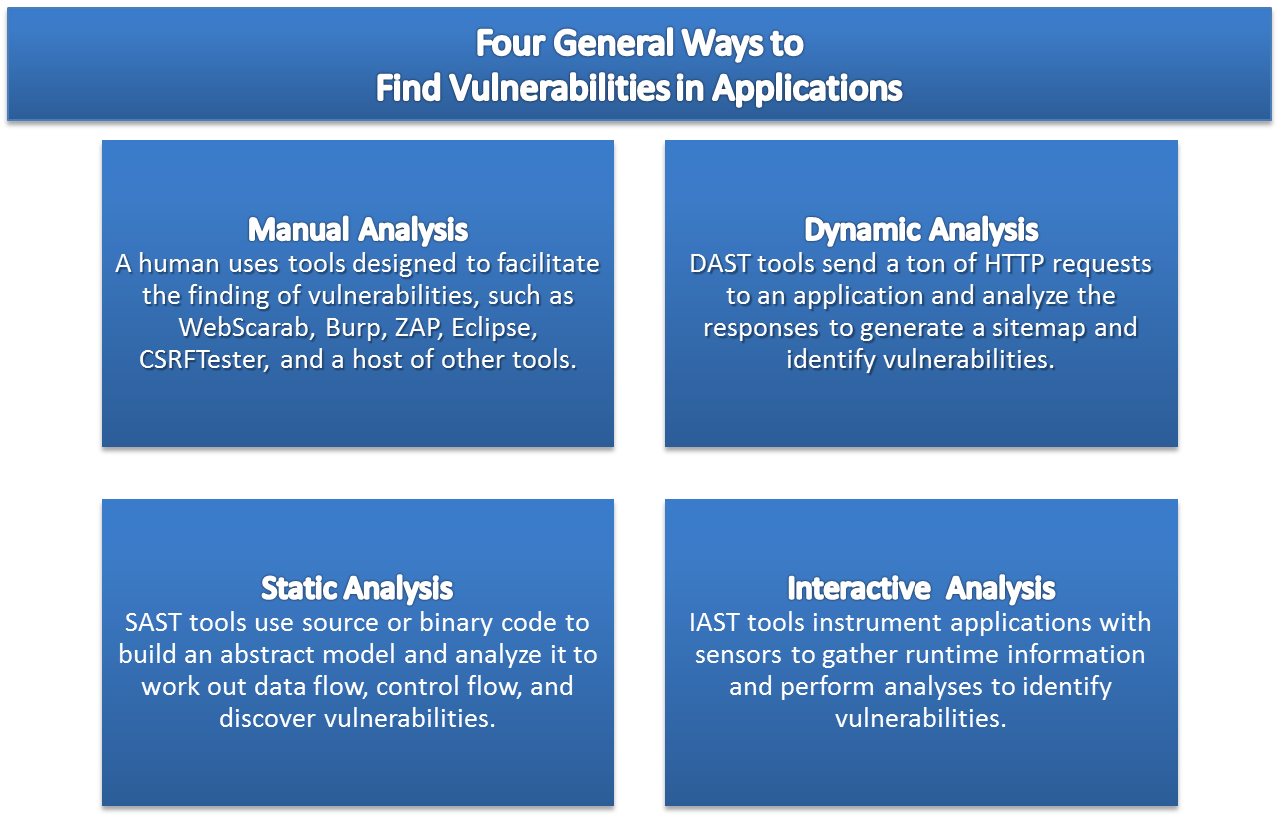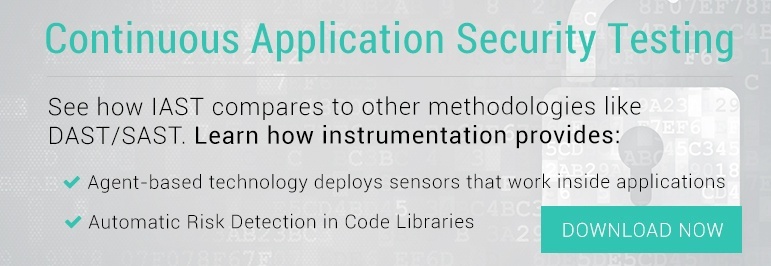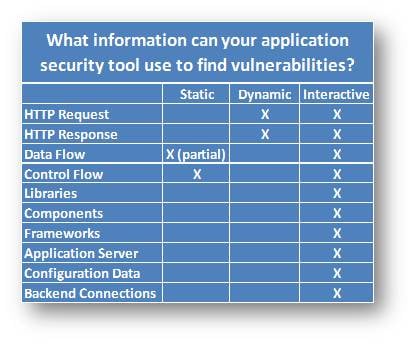
In John Godfrey Saxe's retelling of The Blind Men and the Elephant, six blind men try to teach each other what an elephant is 'like'. They each take hold of a different part of the elephant and proclaim they know what an elephant is. In reality, they know only what they have experienced and, as a result, don't know what an elephant really looks like. Until all of the views are compiled together, they can't quite be certain. (You really should read the poem.) Application security is a lot like this.
We have many different ways to 'view' an application, and your choice can seriously bias your results.

There are generally four ways to find vulnerabilities in applications, e.g. manual testing, dynamic analysis testing, static analysis testing, or interactive analysis testing, and each of them are useful in their own right. And when used together they can produce effective results. I've presented the four ways to find vulnerabilities in applications above. And, full disclosure, I've misled you. I've misled you because this whole approach to categorizing application security tools isn't helpful.
It's misleading because it focuses on *how* information is gathered, rather than *what* information is available to identify vulnerabilities. Who cares *how* the information was gathered? What matters is how complete, accurate, and useful the information is.
As it turns out, the evidence you need to accurately identify and describe a vulnerability is usually scattered in a number of places. The big difference between the various tools is not whether they are static, dynamic, or interactive. What's important is what information the tools have available to identify vulnerabilities. Let's take a look at these:
- HTTP Request - You can collect a lot of good information from HTTP requests about authentication, sessions, use of SSL, certain headers, CSRF tokens, and sitemap information. If you monitor requests passively, you can test in just about any environment. If you use requests to carry out security tests, you'll need an expert to configure and run the scan so it can actually get to any interesting pages.
- HTTP Response - The HTTP responses also provide a wealth of security information. Security headers, CSRF tokens, SSL, autocomplete, access control, and session management all are easily revealed by analyzing responses.
- Data Flow - Data flow is the holy grail of security analysis. Most of the interesting injection problems can only be revealed with a strong data flow engine. Using static analysis tools used to be the only way to really analyze this, but they were difficult to use and suffered from massive false alarms. Newer instrumentation based approaches can perform highly accurate "whole application" data flow analysis including frameworks, libraries, dynamic classloading, and more.
- Control Flow - Several types of vulnerabilities can be revealed through control flow analysis. Did the proper hashing occur during the authentication process? Is there an access control check in every Struts action. Control flow tells us whether the code executes the right steps in the right order.
- Libraries and Components - We've written a lot about this, including here, here, and here, but modern applications are built from libraries, so analyzing them is of critical importance. We need to know if the libraries have known vulnerabilities. But, more importantly, we need to know if the library has unknown vulnerabilities or hazards that an unsuspecting developer used improperly.
- Frameworks - All modern web applications and web services use a framework, and many frameworks have a set of security controls built in. Were these controls used properly? Did the developers invoke them in all the right places? Understanding the framework pays off immensely in providing useful context-sensitive guidance to developers.
- Application Server - The application server, like a framework, also has numerous security controls. Is the application using them properly? Tools that understand the application server in use and what protection it provides can do better analysis.
- Configuration Data - Most security controls can be configured on or off. Many of them have detailed configuration that allows their behavior to be tailored. Configuration data can be in XML files, property files, stored in databases, etc... This is a direct and very accurate way to measure application protection.
- Backend Connections - Understanding where sensitive data is stored is key to being able to perform great security analysis. Tools that can understand backend connections are much more likely to be able to see critical vulnerabilities and describe them to developers.
Again, the big difference between the various tools is not whether they are static, dynamic, or instrumentation-based. What's important is what information the tools have available to identify vulnerabilities.
Static analysis security testing tools only have information from the source code. From this they can sort of work out the control flow and data flow. But because they mostly don't look at libraries, components, and frameworks, they have only a limited view of the application. They also have no insight into HTTP requests and responses or backend connections. Given this, it's not surprising that they report over 80% false alarms.
Dynamic analysis security testing tools only have information from HTTP requests and responses. This means that everything they know about an application has to be gleaned from the HTTP responses. Some of these tools do amazing things given the lack of information. For example, they can sometimes identify blind SQL injection based purely on the timing of HTTP responses. But there are far simpler and more accurate ways to identify blind SQL injection.
Interactive analysis security testing tools, like Contrast™, actually includes some static, some dynamic, and some totally new types of analysis. Because the Contrast agent runs on the application server and its sensors gather information directly from the running application, it has access to the HTTP requests and responses, code, and libraries. Its data and control flow engines are based on the actual running application, not an abstract simulation. It also has direct access to configuration, library, framework, and backend connection information. The best part is that Contrast has all this information integrated together, in context.
For example, when we identify SQL injection, we know the exact HTTP request parameter it came from, the full data flow, the framework that parsed it from the form, the exact lines of code involved, the database library, the backend connection, the configuration data, and more. And all the information is integrated, in context, during the analysis -- not simply smushing together the results of two separately running tools. This not only allows extremely accurate vulnerability identification, but allows us to provide all the information that developers need in order to remediate problems quickly and effectively.
Why do we like the Contrast approach so much? Because we can use *ALL* this information, in real time, without any extra hardware or infrastructure, and without requiring a security expert to run the tool. There really is no comparison -- Contrast simply has too many advantages over existing approaches.

So maybe it's time to stop thinking of tools in terms of "static" or "dynamic." What really matters is what information the tools have access to. Which brings us back to the blind monks determining what an elephant looks like; because at the end of the day, static and dynamic tools do the best they can with the limited information they have, we just think it's time to take the blindfolds off.


.jpg)







